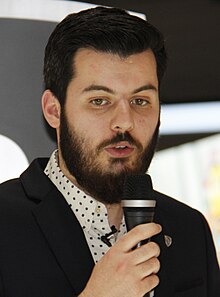Rimac Automobili
Rimac Automobili's first model, the Concept One, was allegedly the world's fastest production[4] electric vehicle,[5] even though only 8 of them were ever produced.
[7][8] Working on his own, he converted his BMW 3 Series (E30) to incorporate an electric powertrain and subsequently gained attention from the press and investors.
[8][9] When he was 19 years old, Mate Rimac began converting an E30-M3 which served as his first test mule:[10]"I owned an old BMW E30 (MY 1984) which I used for drift and circuit races.
For this reason, I started to gather a team of experts to develop our own components since I believed that the electric propulsion could give much more compared to what was available on the market.
The "green monster" develops 442 kW (601 PS; 593 hp) and 900 N⋅m (664 lb⋅ft) of torque, reaches 100 km/h from a standstill in 3.3 s and has a top speed of 280 km/h (174 mph).
*Records subject to official FIA approval (pending)[10][22][23] The original BMW went through five stages of reinvention and now, says Rimac, "it got faster, lighter and more reliable each time."
With a curb weight of 1,850 kg, and a power output of 960 kW (1,305 PS; 1,287 hp), the Concept One can reach 100 km/h from a standstill in 2.6 seconds and continue to accelerate to a top speed of 355 km/h (221 mph).
[34][35] The first car was for Spanish company Applus+ IDIADA, called the Volar-e.[36][37] The second buyer is Paul Runge, one of the shareholders of Rimac automobili.
The batteries are located under the floor of the vehicle together with the other heavy propulsion components, which leads to a low center of gravity and better handling.
The battery charges fully in 30 minutes on a 200 kW power supply station, and can then operate the vehicle for around 510 km (320 miles).
[44] At the 2017 Geneva Motor Show the company announced the establishment of official dealerships of its brand in Europe, North America and the Middle East, with dealers Manhattan Motorcars, PACE Germany and Al Zarooni Group.
The carbon fibre body construction results in a total weight of 2,150 kg (4,740 lb), including the heavy battery packs.
The Nevera will have Level 4 self-driving capability, according to Mate Rimac; it has eight cameras, a LIDAR, six radars, and twelve ultrasonic sensors.
It comes in a one-off shade of blue, with new wheel design, and is supplied with six liters of champagne and two flutes in the boot of the car.
[50] In 2018, it entered a technical partnership with Automobili Pininfarina, whose first car, the Battista, is said to be based on the same architecture and uses the same powertrain[51] as the Nevera.
The vehicle utilizes LIDAR and computer vision for navigation and lacks any form of driving input from the occupants.




